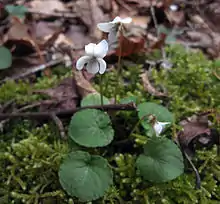| Viola blanda | |
|---|---|
 | |
| Scientific classification | |
| Kingdom: | Plantae |
| Clade: | Tracheophytes |
| Clade: | Angiosperms |
| Clade: | Eudicots |
| Clade: | Rosids |
| Order: | Malpighiales |
| Family: | Violaceae |
| Genus: | Viola |
| Species: | V. blanda |
| Binomial name | |
| Viola blanda | |
| Synonyms | |
Viola blanda, commonly called the sweet white violet,[2] is a flowering perennial plant in the Violet family (Violaceae).[2] It is native to parts of south-eastern and south-central Canada and the eastern, and north-central, United States.[2] Its natural habitat is in cool, mesic forests.[3]
Description
The sweet white violet grows from 6 to 12 inches high. They grow small white flowers in spring and early summer. The lower petals have purple veins. The upper petals are often twisted or bent backwards. The stalks are a reddish tinged. They grow 1-2 inch long heart shaped leaves with a few scattered hairs.
The white violet has demonstrated a weak ability to respond to climate change by shifting its flowering time in some areas of its range.
References
Wikimedia Commons has media related to Viola blanda.
Wikispecies has information related to Viola blanda.
- ↑ "Viola blanda". Germplasm Resources Information Network. Agricultural Research Service, United States Department of Agriculture. Retrieved 2010-03-09.
- 1 2 3 USDA, NRCS (n.d.). "Viola blanda". The PLANTS Database (plants.usda.gov). Greensboro, North Carolina: National Plant Data Team. Retrieved 2010-03-09.
- ↑ "Flora of the Southern and Mid-Atlantic States".
This article is issued from Wikipedia. The text is licensed under Creative Commons - Attribution - Sharealike. Additional terms may apply for the media files.
